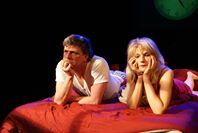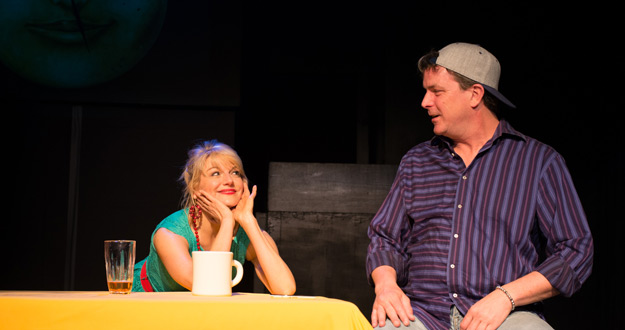The Washington Post
By Jane Horwitz, Wednesday, March 19, 3:36 PM
‘Happily Ever After’ is a winningly acted meditation on dysfunctional relationships
Many are the ways in which men and women misconstrue, misapprehend and just plain miss the boat when it comes to love and marriage. These are enumerated in Cristina Colmena’s amusing trio of playlets under the title “Happily Ever After,†having its world premiere in a winningly acted bare-bones production by Ambassador Theater.
It’s a lean staging and a mere hour of theater — but a pretty full hour, all the same, at Flashpoint’s intimate Mead Theatre Lab. However, a more accurate title might be “Happily Ever After — Not.â€
Colmena’s playlets hit the mark more often than they miss. As staged rather broadly for such a small space by Hanna Bondarewska (Ambassador Theater’s artistic director), they still elicit laughs of recognition. Who, after all, hasn’t had one or two dysfunctional relationships?
The three pieces are not equally funny or incisive, but they show that dramatist Colmena has flair, and a subtly European mind-set when it comes to romance. That follows, since she hails from Spain, though lives in New York now. The Washington-based Ambassador Theater, now in its fifth year, is devoted to staging theatrical works by authors from around the world. (“Happily Ever After†is performed in English.)
Actors Karin Rosnizeck and Doug Krehbel play the couples in each playlet, all named merely He and She. Brief blackouts allow them to switch with simple changes of costumes and props. A 45-degree turn of the large table, which sits lengthwise during the first scene, transforms it into a bed for the second and third scenes.
A title projected at the rear of the stage announces the first piece — “Misunderstandings.†While not unamusing, it is the least emotionally resonant and most artificial of the three. The lights come up on a young woman and young man, probably 20-somethings, sitting at opposite ends of the table. They were supposed to meet and patch up a quarrel, but one of them got the name of the bar wrong, so they each wait alone, too stubborn to call the other. They fume, but only to the audience. Once or twice, the actors move into the same space, reenacting flashbacks of the earlier, happier days of their affair.
In “Don’t Take It Personally,†the strongest of the three pieces, a pair of 40ish sophisticates smoke languidly after an anonymous liaison that led from a bar to her bed. Now she’s ready for him to leave, though by the clock it’s only pre-dawn. He wants to linger and cuddle. When she demurs, he calls her “cold.†She claims it’s self-protection, listing what can happen when you open your heart even a little: dating, then marriage, then children, then an apartment at the beach, then divorce. “Don’t Take it Personally†comes the closest to a bull’s-eye in performance, direction and authorial insight. It includes fewer speeches to the audience and more interaction between characters, which gives it a dramatic punch that goes beyond mere wit. And a tango interlude, in which the couple have a second erotic encounter imagined in steamy choreography, is fun, if constricted, on the tiny stage.
A married couple in their 60s take the spotlight in “Melodrama.†He snaps photos of Her for a 30th-anniversary celebration that their daughter is planning. While he clicks away, his wife breaks her pose to excoriate him and vent about her long marital misery. But her speeches are for the audience’s ears only. And when he finally pipes up, his words, too, are just for the audience. In the end, their fights remain unfought, except in their heads and our ears.
Lots of elements in “Happily Ever After†invite a more avant-garde approach than director Bondarewska takes. She mines the humor and familiarity in Colmena’s script, but this set of plays, because of how it is constructed, offers both professionals and students a chance to experiment.
“Happily Ever After†and “Typing,†another play by Colmena, have been published in “New Plays From Spain: Eight Works by Seven Playwrights†(Martin E. Segal Theatre Center Publications, New York, 2013), where the scripts appear side by side in Spanish and English.
Jane Horwitz is a freelance writer.
‘Happily Ever After’
By Cristina Colmena. Directed by Hanna Bondarewska. Sound and video design, David Crandall; set, Greg Jackson and Jonathan Rushbrook; lighting, Stephen Shetler; costumes, Basmah Alomar; choreography, Francesca Jandasek and Dan Istrate. Tickets $22-$37. About one hour. Presented through March 30 by the Ambassador Theater at Flashpoint’s Mead Theater Lab, 916 G Street, NW. Visit www.aticc.org.













 Un momento de la obra ’Happily ever after’, de la española Cristina Colmena y estrenada en Washington.Magda Pinkowska Gorman
Un momento de la obra ’Happily ever after’, de la española Cristina Colmena y estrenada en Washington.Magda Pinkowska Gorman
